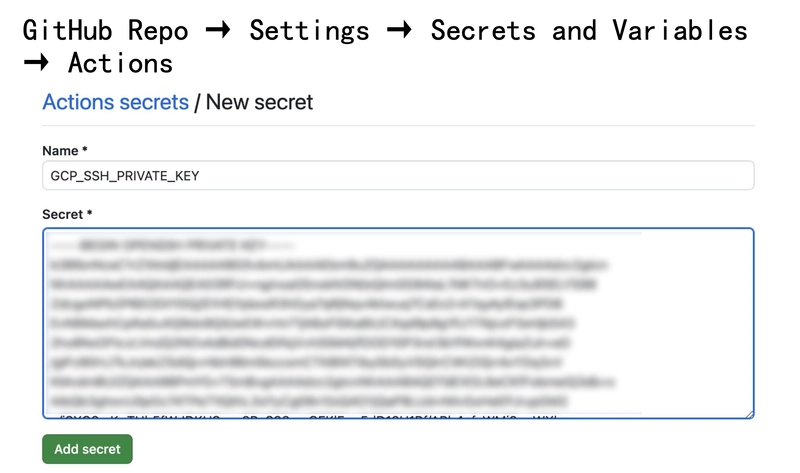🚀 Why CI/CD?
CI/CD automates every stage of your software delivery process:
- CI (Continuous Integration): Automatically builds and tests your code on each commit.
- CD (Continuous Deployment): Automatically deploys your application to the production environment after passing tests.
Together, CI/CD reduces errors, improves productivity, and ensures reliable releases—critical in agile and DevOps workflows.
🏗️ Project Overview
You’ll learn how to:
- Use GitHub Actions to automate Maven build and GCP deployment.
- Securely manage SSH keys and secrets.
- Use Docker for containerization (optional).
- Deploy to a GCP Compute Engine VM running Ubuntu.
🔧 Prerequisites
Before you begin:
- GCP project with Compute Engine VM set up (Ubuntu OS, Java installed).
- GitHub repository for your Spring Boot project.
- Domain name (e.g., from No-IP) and optional SSL certificate via Let’s Encrypt.
- SSH key pair added to your GitHub and GCP metadata.
- Application setup (e.g.,
application.properties, MySQL, Redis, etc.) already running on the VM.
📁 GitHub Repository Setup
-
Add Secrets to GitHub:
Navigate to
Settings → Secrets and Variables → Actions, and add:-
GCP_SSH_PRIVATE_KEY: Your private SSH key (no passphrase). -
GCP_VM_IP: Your VM’s external IP. -
GCP_VM_USER: The SSH username (usually your GCP email-based user). -
KEYSTORE_BASE64: Base64 encodedkeystore.p12SSL cert file.
-
To create KEYSTORE_BASE64:
base64 cert/keystore.p12 > keystore_base64.txt
-
Public Key in GCP VM:
Upload your public SSH key (
gcp_ssh_key.pub) using GCP’s OS Login or manually via~/.ssh/authorized_keys.
📜 GitHub Actions Workflow File (.github/workflows/deploy.yml)
name: Deploy Java App to GCP VM
on:
push:
branches: [main]
jobs:
build-and-deploy:
runs-on: ubuntu-latest
steps:
- name: Checkout code
uses: actions/checkout@v4
- name: Set up JDK 23
uses: actions/setup-java@v3
with:
distribution: 'temurin'
java-version: '23'
- name: Build with Maven
run: mvn clean package -DskipTests
- name: Set up SSH
run: |
mkdir -p ~/.ssh
echo "${{ secrets.GCP_SSH_PRIVATE_KEY }}" > ~/.ssh/id_rsa
chmod 600 ~/.ssh/id_rsa
ssh-keyscan -H ${{ secrets.GCP_VM_IP }} >> ~/.ssh/known_hosts
- name: Deploy JAR to GCP VM
run: |
scp -i ~/.ssh/id_rsa target/*.jar ${{ secrets.GCP_VM_USER }}@${{ secrets.GCP_VM_IP }}:/home/${{ secrets.GCP_VM_USER }}/app.jar
ssh -i ~/.ssh/id_rsa ${{ secrets.GCP_VM_USER }}@${{ secrets.GCP_VM_IP }} << 'EOF'
sudo pkill -f "java -jar" || true
nohup java -jar /home/${{ secrets.GCP_VM_USER }}/app.jar --spring.config.location=/home/${{ secrets.GCP_VM_USER }}/application.properties > app.log 2>&1 &
EOF
🔐 SSL and Secrets Management
Use Let’s Encrypt to generate a free SSL certificate:
sudo apt install certbot
sudo certbot certonly --standalone -d your-domain.ddns.net
Convert to keystore.p12 for Spring Boot:
openssl pkcs12 -export -in fullchain.pem -inkey privkey.pem -out keystore.p12 -name mysslkey -password pass:yourpassword
Encode and add it to GitHub as KEYSTORE_BASE64, then restore it in your workflow:
- name: Restore keystore.p12
run: |
mkdir -p src/main/resources/cert
echo "${{ secrets.KEYSTORE_BASE64 }}" | base64 --decode > src/main/resources/cert/keystore.p12
🐳 Bonus: Dockerizing Your Java App
To containerize your app:
- Create a
Dockerfile:
FROM openjdk:17-slim
COPY target/*.jar app.jar
EXPOSE 8080
ENTRYPOINT ["java", "-jar", "app.jar"]
- Add Docker build/push to your GitHub Actions:
- name: Build Docker Image
run: docker build -t youruser/demo-spring-app .
- name: Push to Docker Hub
run: |
echo "${{ secrets.DOCKER_HUB_ACCESS_TOKEN }}" | docker login -u "${{ secrets.DOCKER_HUB_USERNAME }}" --password-stdin
docker push youruser/demo-spring-app
- Pull and run the container on GCP VM:
docker pull youruser/demo-spring-app
docker run -d --name demo -p 8080:8080 youruser/demo-spring-app
✅ CI/CD Flow Summary
- Developer pushes code to GitHub
mainbranch. - GitHub Actions:
- Builds the project using Maven.
- Deploys
.jaror Docker image to GCP VM.
- App runs on VM, accessible via your domain and secured with SSL.
🎯 Conclusion
Setting up a CI/CD pipeline with GitHub Actions and GCP Compute Engine offers a powerful, scalable, and fully automated deployment workflow for your Java apps. By leveraging GitHub’s native integration with Secrets and Actions, plus the flexibility of GCP, you can deploy with confidence and consistency.



Top comments (0)